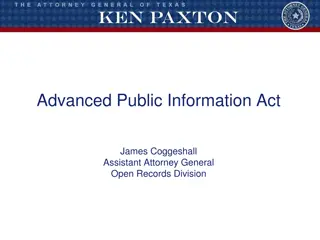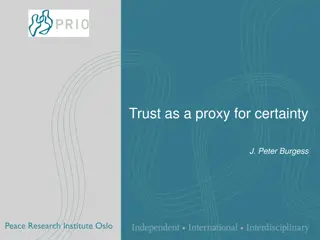Understanding Procedural Justice and Public Trust in the Justice System
The discussion delves into the goals of the justice system, the importance of public trust and confidence, and the concept of legitimacy in the context of the courts. Despite improvements in the delivery of justice, trust and confidence among Americans, especially in minority groups, remain a challenge. Focusing on procedural justice and community influence is crucial to enhancing legitimacy and public perception of the legal system.
Download Presentation

Please find below an Image/Link to download the presentation.
The content on the website is provided AS IS for your information and personal use only. It may not be sold, licensed, or shared on other websites without obtaining consent from the author. Download presentation by click this link. If you encounter any issues during the download, it is possible that the publisher has removed the file from their server.
E N D
Presentation Transcript
PROCEDURAL JUSTICE AND THE COURTS By: Tom Tyler Conference of State Court Administrators (COSCA). December, 2011. San Antonio, Texas.
Goals of the justice system. To deliver fair and impartial justice. To have the confidence of the American people. To be trusted and viewed as legitimate.
Conflicting goals? There is no reason that these goals should necessarily be in conflict. In fact, we might initially think that objective improvements in the delivery of fair and impartial justice would lead to higher levels of public trust and confidence (i.e. higher legitimacy).
Public trust and confidence. Studies of the courts suggest that the objective quality of the criminal/civil justice system has improved over recent decades. These objective improvements in the delivery of justice have not been matched by higher levels of trust and confidence among Americans. This is especially true of minority group members. Trust remains an issue and many members of the public come to court without confidence in judges or the law.
Legitimacy. These findings suggest that we address public views about the legitimacy of the courts directly as a distinct issue. Ask why people view the courts and the justice system as legitimate.
Legitimacy. Legitimacy reflects three related issues: Trust and confidence in the justice system The willingness to defer to legal authority. Belief that the actions of legal authorities are morally correct and appropriate. Often indexed as trust and confidence.
How can we influence legitimacy in the community? We need to focus on how court policies and practices influence the views that the public has about legitimacy. Especially focus on the views of the minority community
What shapes legitimacy when people deal with the legal system? The primary issue shaping people s views about legitimacy when dealing with the legal system is whether authorities are exercising their authority in fair ways - procedural justice.
9 9/29/2024 Procedural justice as an idea. Procedural justice develops from research showing that the fairness of how cases are handled has an important influence upon people s evaluations of their experience in the court/criminal justice system. Procedural justice is more important than the outcome of those experiences.
Defined in terms of four issues. Quality of decision making. Voice. Neutrality. Quality of treatment Respect for people and their rights. Trustworthiness.
Studies suggest that judgments about court/policing practices shape public behavior Does the public believe that the courts/police exercise their authority in fair ways (procedural justice)? -Defer to court/police decisions/authority. Does the public accept the legitimacy of legal authority? -Generally accept and obey the law -Cooperate with the police to fight crime. -Support legal institutions.
Research studies support the role of procedural justice. Study of Californians Conducted in Oakland and Los Angeles. Assessed why people voluntarily defer to judicial decisions. 1656 interviews of people who had recent personal experiences with legal authorities (85% with police).
Measures used in this study Evaluations of experience Outcome. Outcome favorability (The decision favored me.) Outcome fairness (I received the outcome I deserved.) Procedural justice. The decisions were made in fair ways. I was treated in fair ways. Reaction to experience Voluntary deference I willingly accepted the decisions made.
Why do people accept court decisions? 0.8 0.71 Strength of connection 0.7 0.6 0.5 0.4 0.3 0.19 0.2 0.07 0.1 0 Decision acceptance Outcome favorability Procedural fairness Outcome fairness
Willingness to accept decisions based upon reason for being in court. 0.8 Strength of connection 0.68 0.7 0.65 0.6 0.5 0.4 0.3 0.21 0.2 0.16 0.12 0.1 0.04 0 -Bringing problem to court (plaintiff) Required to come to court (defendant) Outcome favorability Procedural fairness Outcome fairness
Summary The way members of the public perceive the courts and evaluate court practices shapes their views and behaviors. The key issue is procedural justice and, in particular, how people are treated by the courts. The access that people seek is access to a just procedure for dealing with their case.
17 9/29/2024 Common misconception #1. Procedural justice does not suggest that people are happy if they lose/receive an undesired outcome. No one likes to lose. It suggests that people recognize that they cannot always win/get what they want. Accept losing more willingly if the procedure used is fair.
18 9/29/2024 Procedural justice approach. Minimize the idea of winning and losing (shift focus). Focus upon delivering gains for all parties. Someone to listen to and consider their story; understand their concerns. Recognize and acknowledge their right to seek justice in the courts.
19 9/29/2024 Common misconception #2. You cannot deliver undesired outcomes without being unpopular. Studies show that trust and confidence increases when people experience procedural justice during an experience in which they receive a negative outcome.
3.7 3.5 3.3 Trust and confidence Cooperation P < .05 3.1 2.9 2.7 P < .05 2.5 Pre Post Change in trust and confidence and in willingness to cooperate with legal authorities as the result of receiving a negative outcome through a fair procedure.
21 9/29/2024 Misconception #3. When the stakes are high, only outcomes matter. Studies suggest that procedural justice issues remain important when The monetary stakes are high. People are very invested (child custody). Important moral or value based questions are at issue.
22 9/29/2024 Trust and confidence in the California justice system by type of prior personal experience. 0.7 0.63 Strength of connection 0.59 0.58 0.6 0.5 0.42 0.38 0.4 0.35 0.27 0.3 0.25 0.23 0.2 0.08 0.07 0.1 0.06 0.06 0.04 0.03 0 Traffic/small claims Family Criminal Civil court Attorneys Performance Make fair decisions Procedural fairness
Cost and delay. These results also show that personal instrumental concerns such as willing or losing or court based issues such as cost and delay are not the key concerns that shape how people evaluate court legitimacy. People focus on whether justice is done.
Justice in everyday law. These procedural justice findings apply to people s everyday encounters with the legal system (courts; police). Increase decision acceptance (maintained over time). Diminish anger and defiance toward authorities and system. Create legitimacy.
Criminals. These findings also apply to criminal s reactions to criminal justice proceedings during case disposition; in prison; and post-prison. More accepting of decisions that are fairly made. Builds legitimacy. Lowers violence in prisons. Lowers subsequent recidivism.
Victims. The reactions of victims, their families & community, and the general public to criminal justice proceedings is shaped by procedural justice judgments. Victims want to participate, have views heard. Example of a procedure viewed as fair: Allow victims to speak at sentencing hearings.
27 9/29/2024 Which aspects of treatment matter? Four key procedural justice ideas. Voice Neutrality Respect Trust
28 9/29/2024 The meaning of procedural justice (California study personal experience). 0.6 0.55 Strength of connection 0.5 0.44 0.38 0.4 0.29 0.3 0.2 0.12 0.1 0.03 0 Procedural justice Outcome favorability Voice Respect Outcome fairness Neutrality Trust
29 9/29/2024 Voice People want to have an opportunity to tell their side of the story in their own words.
30 9/29/2024 Case management implications. Create forums in which people can voice their side of the story. Ex: mediation. Give people who appear in court the chance to state their case before making decisions.
31 9/29/2024 Neutrality People bring their disputes to the court because they view judges as neutral, principled, decision makers who... Make decisions based on facts and rules, not personal opinions. Apply rules consistently across people and over cases.
32 9/29/2024 Case management implications. Give information about what is happening throughout emphasize the procedures being used (how decisions are being made). Be transparent and open about how decisions are being made. Give an explanation. Cite relevant rules. Explain that decisions are based upon the rules, not your personal views. Provide information about court procedures. People coming to court are often confused about how cases are handled. Have a brochure on court procedures. Have a help desk.
33 9/29/2024 Respect. People come to court about issues that are important to them, irrespective of whether they have a strong legal case. Take people s concerns seriously Show respect for them as people and as citizens who have the right to address the court about their issues.
34 9/29/2024 Case management implications. Courtesy; Politeness; Respect for people. Train personnel to think of people from a customer satisfaction perspective. Courts are not stores and litigants cannot simply buy what they want. But they are entitled to feel that they are taken seriously. Respect for their rights. Give people information about what their rights are. Emphasize that they have the right to bring their problems to court and that, when they do, those problems will be dealt with fairly. Tell them how to complain to higher authorities.
35 9/29/2024 Trust The central factor influencing public evaluations of judges is an assessment of the character of the decision maker (sincere, caring). Are you listening to and considering people s views? Are you trying to do what is right for everyone involved? Are you acting in the interests of the parties, not out of personal prejudice?
36 9/29/2024 Case management implications. What can you do to be viewed as trustworthy? Give evidence that you are listening to people. Acknowledge people s needs and concerns, even when you cannot base your decision on them. Express awareness of and empathy for their situation. Take adequate time to consider arguments when making decisions. Treat the matter seriously. Explain your decision. Demonstrate that you considered people s arguments by referring to them.
System level approach. The California courts are already acting on this idea with a Procedural fairness initiative. Based upon their own independent research confirming these ideas. Responding to diversity, increases in pro se representation, public distrust of the courts. Every experience with the courts litigant, juror, etc. should build legitimacy. This should occur at all stages: arresting officers; jail staff; court help-desk; bailiff; judge.
Implementing change in an austere era. Changes in objective procedures to heighten perceived fairness can be straightforward. Giving people a chance to tell their side of the story, explaining policies and procedures, giving reasons for decisions, providing ways to make complaints. These policy changes are inexpensive. Not like adding more officers, buying expensive technology Low cost changes that are high impact.























